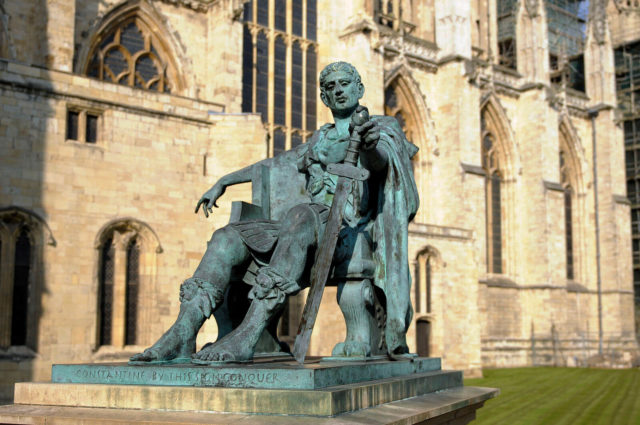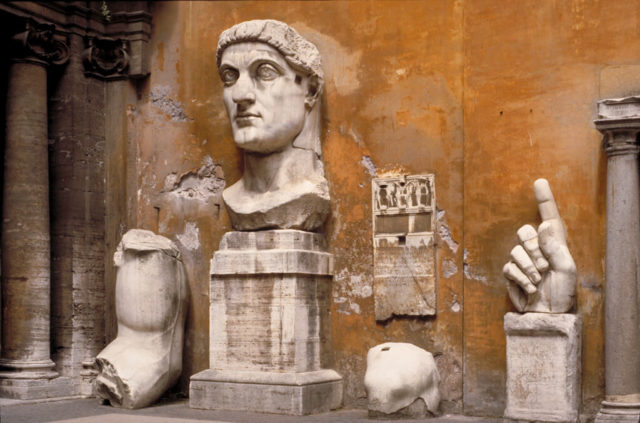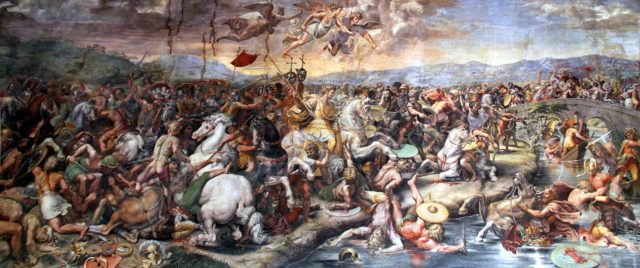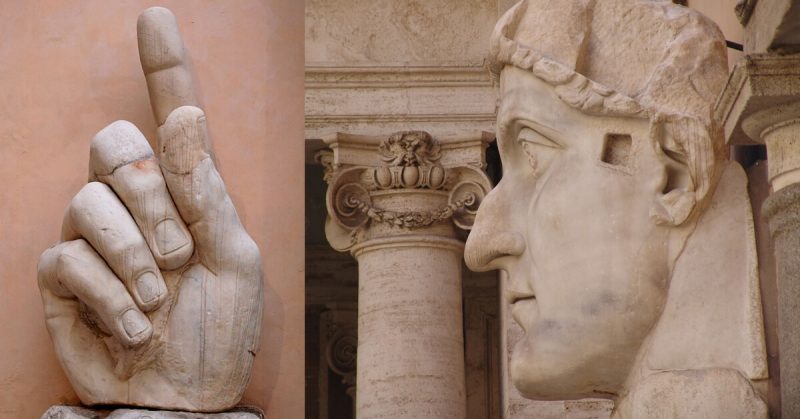Constantine the First, also known as Constantine the Great, was one of Rome’s most capable rulers. Rising to power in the early fourth century, he provided a period of relative stability and turned the Empire toward Christianity.
He did not do this after inheriting the throne. He had to take it by force of arms.
The Usurper from the Setting Sun
By 306 AD, imperial power in the Roman Empire was divided. Separate emperors held sway in the east and west. Along with their deputies, the official number of rulers was four. These posts were not inherited but were appointments made by preceding emperors.
Constantine was the son of Constantius, who many expected to become an emperor when Diocletian stepped down in 305. Constantius was passed over, creating resentment among his followers.
A year later, Constantius died while at his post governing Britain, an island Constantine referred to as the land of the setting sun. Constantine was immediately hailed as his successor and as emperor.

Dynamic Commander, Veteran Soldiers
With the backing of his troops, Constantine set out to take control of the empire. In this, he had two key advantages over his main rivals.
Firstly, he was a dynamic commander, ready to make bold moves for victory.
Secondly, he had the backing of veteran soldiers. Based in Rome’s troubled western border regions of Britain and the Rhine, both legionaries and officers had experience of war.
War in the West
While other leaders struggled to control Italy, Constantine remained in the northwest corner of the empire, facing external threats. He continued his father’s work building defenses and fending off barbarian tribes.
His first campaigns were against the Picts in northern Britain. However, it was when the Franks poured across the Rhine into Gaul that he shone. Leading his armies into Gaul, he defeated the Franks. They were driven back. Their leaders were captured and fed to wild animals for the entertainment of Roman citizens.

Into Italy
In 310, a former Roman ruler and ally of Constantine’s family, Maximian, rebelled against him. Constantine put down the revolt. It ended the relationship between the two families, committing them to war.
Maximian’s son, Maxentius, controlled Italy and the symbolically vital city of Rome. He had already defeated other attempts to take control of the peninsula. Following his father’s death, he became Constantine’s opponent.
Marching south, Constantine led a quarter of his army into Italy. It is probable they consisted of troops who were relatively mobile and not committed to guarding the borders he had fought to secure. Many of his advisors were wary of this strategy, but Constantine convinced them it was for the best.
They scattered the armies sent against them by Maxentius. Town after town opened its gates to Constantine, welcoming him as emperor.
Maxentius and his army retreated behind the walls of Rome, destroying bridges as they went.
The Milvian Bridge
What followed was a turning point for the empire.
The discontent of his citizens compelled Maxentius to leave the safety of Rome and face Constantine. Having destroyed the Milvian Bridge to hinder Constantine’s crossing, he was forced to replace it with a bridge of boats and wood to get his men across. On October 28, 312 AD, he formed his army on the north bank of the Tiber and faced the invaders.
Lacking the experience of Constantine’s men Maxentius, and his troops were routed. They fled back across the bridge, which collapsed under the weight of men, horses, and armor. Maxentius drowned.
As so often happened, Constantine thanked divine favor for granting him victory. Unlike his predecessors, he gave thanks, not to the pagan gods of Rome but the Christian God. Having supposedly received a vision on the night before the battle, he had converted to Christianity and ordered his men to mark their shields with Christian symbols.
The Battle of the Milvian Bridge, therefore, became a religious as well as a political turning point.

A Growing Army
Brought to power by the army, Constantine took care to nurture it. Fresh legions were raised. Detachments were withdrawn from the borders to provide a more powerful mobile fighting force. Armies were reorganized, including the creation of new cavalry units.
Many of the soldiers Constantine relied on came from the edges of the western empire. Moorish archers and German cavalry played an important part in taking Rome. He also continued to recruit from the imperial heartlands. When men tried to avoid conscription by mutilating themselves, Constantine brought in a law punishing them with civil work within their communities.
Unification Through War
For 12 years, Constantine ruled in the western half of the empire while another man, Licinius, ruled in the east. Constantine, however, was ambitious to rule the whole empire.
In 324, the two rulers faced each other in a decisive struggle. In a battle on the Bosphorus Straits, Licinius and his army were destroyed.
Constantine emerged triumphant, ruler of the whole empire. To celebrate this, he set to work rebuilding the city of Byzantium as his new eastern capital. He renamed it after himself; Constantinople.

Stability Amid Decay
Constantine continued to rule for another 13 years, dying in 337. During that time, he fought off attacks from tribes on the edges of the empire. He pushed back the borders, retaking territory lost during the 3rd century. Near the end of his reign, he stirred trouble with the Persians to the east, a conflict which he left to his successors.
Although it took a war to bring about, Constantine’s rule provided a period of relative stability and success for the Roman Empire. The decline of the preceding decades was turned around, if only temporarily. It had been achieved by one man’s military skill and ambition.
Sources:
Kate Gilliver, Adrian Goldsworthy and Michael Whitby (2005), Rome at War: Caesar and his Legacy.
Adrian Goldsworthy (2003), The Complete Roman Army.
General Sir John Hackett, ed. (1989), Warfare in the Ancient World.
